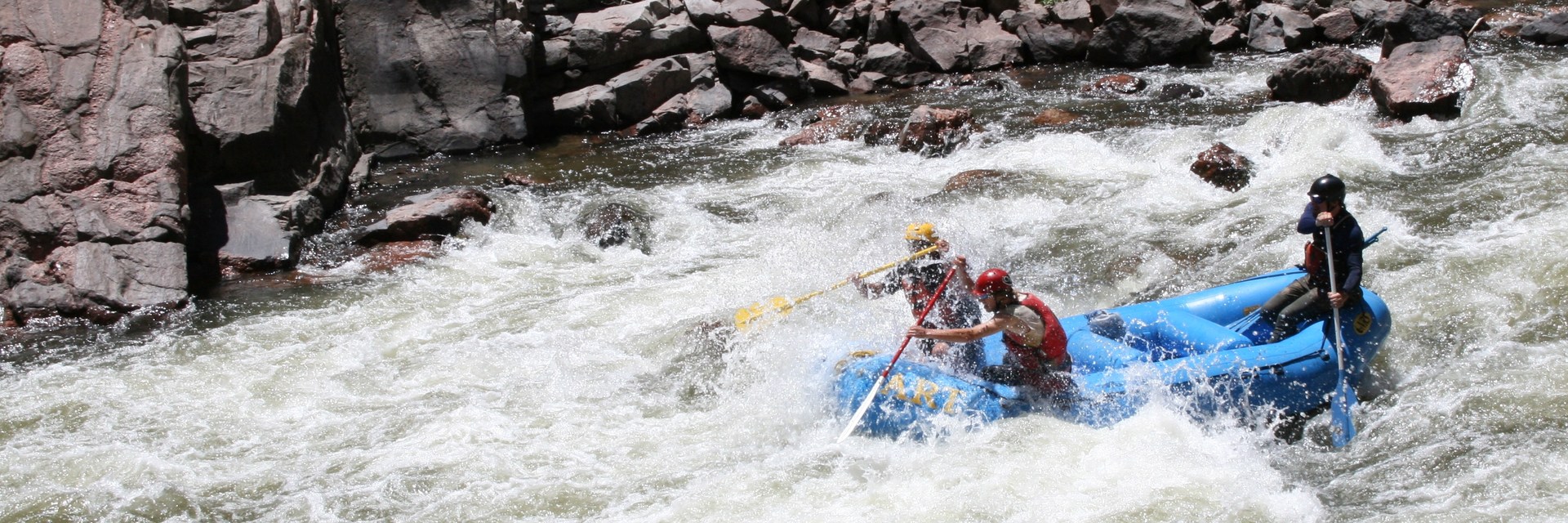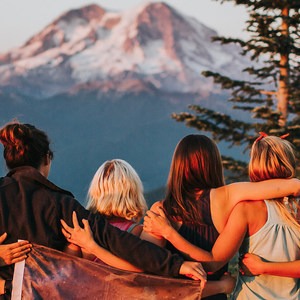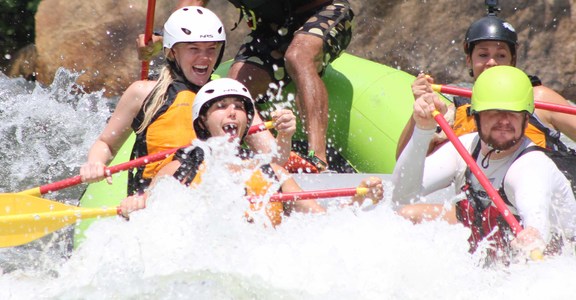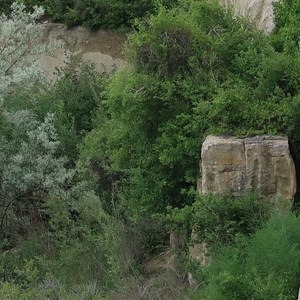The Arkansas River through Browns Canyon was running at about 3,450 cubic feet per second, and Jessica and I were driving through 2 inches of fresh snow on Tennessee Pass to get there. After delivering historic snowpack during the ski season, winter of 2019 was still taking a victory lap in mid-June. We had debated canceling the trip based on the weather forecast alone, which was supposed to be a high of 50 and rainy. The truth is, though, that any day on the river is a good one, and if you cancel a trip because of something that hasn’t happened yet, there is a 100% chance that you won’t have any fun at all.
I was along for the ride, never having run this stretch of iconic Colorado whitewater despite 15 years of guiding and river trips on the Western Slope. Jessica and Leia, who would join us at the put-in, had both guided on the Ark for several seasons. Not only had they both run Browns at even higher flows, but legend has it that Leia once guided The Numbers, a much more challenging section of the same river, in near-total darkness one night, when her shuttle took too long and she really wanted to get on the river.
Together, the three of us had 28 seasons of whitewater guiding experience and a total of six kids under seven. In our more recent pasts, since the advent of children, most of the whitewater had been removed from our rafting. Today was necessary because, while we love the river no matter what shape it is, everyone was dying to sink their paddles in a little deeper.
On a typical weekend in June, you can usually find thousands of people jostling for space at the Fisherman’s Bridge put-in, waiting for the opportunity to run Browns Canyon, but not today. In the wide expanse of a nearly empty parking lot, we layered up for freezing temps while absorbing the view.
To the west, the Collegiate Peaks and their 14,000-foot peaks were still draped casually as in mid-winter for the approaching summer solstice. To the east, the rugged terrain along the Upper Arkansas began to look a lot like a giant toddler threw a tantrum with house-sized boulders. Rough, igneous lumps were scattered across the landscape and in the river, piling up to form jagged cliff-faces or interrupting otherwise cultivated fields. For whitewater enthusiasts, this cluttered effect, coupled with a narrow canyon and high water, meant that the rapids would be big but technical, boulders and bedrock working together to funnel that icy current into epic drops.
We got on the water as fast as possible, and after a brief warm-up section, the first rapid, Canyon Doors, did not disappoint. A slow start to the season and far too many float-trips meant that my baptism back into real whitewater was breathtaking. Literally—it was so cold I couldn’t breathe for a second as the first wave crashed right into my face. By the second wave, I quickly remembered to lean in and let my helmet take the sting out of it. And by the third wave, I remembered that I would be grinning like an idiot for the next 10 miles.
As a female guide, I tend to read the river very differently than my male counterparts. I know I don’t have the brute strength to make a Hail Mary pull at the last minute, so my setup begins when I first sight the horizon line. This often means that, when I am a passenger, I spend a good 10 yards above every obstacle trying to manifest the boat over to the line I would be on, twitching slightly like a mom who stomps a non-existent brake pedal while teaching her teenage son to drive.
But with Jessica, all I had to do was everything she told me. Paddling in a small raft for a guide who reads the river exactly the same way you do is pure joy. Every rapid was like a choreographed dance, our paddles working with the current instead of against it. When Leia took over to guide the last few rapids of the canyon, it was the same. Every big hit, every wave train, every drop and pivot was lined up for maximum stoke. Even the weather turned out to be beautiful. Apparently, the morning of June 10 was actually the last day of winter, and by midday our skies were sunny, warm, and (almost) seasonable.
Next up, Pinball. A technical, rocky rapid at low water with lots of large boulders to avoid, right now it looked like a 50-yard explosion of water. Holes formed and crashed irregularly, trying to spin us off the line, but once again, we had the perfect run.
The Arkansas River through Browns Canyon is considered a class III section, and it is runnable as low as 300 cfs for smaller rafts. Today, it was 10 times larger than its lowest viable flow, and the class of rapids was closer to a class IV for much of the canyon. A swim at this level would be a very bad idea, and a flip could have deadly consequences. The current was icy and fast, making it difficult for anyone in the water to reach the shore without previous whitewater swimming experience. Luckily, I had plenty of that thanks to years of bad decision making, and so did everyone else.
“Oh man, that left-side lateral!” I said.
“I know, it was way steeper than last time I ran it,” Jessica said.
Leia chimed in. “But you lined it up with that pivot move, nice work.”
“Seriously,” I said. “Good hit.”
The three of us celebrated the line on every rapid, interrupting the traditional guide recap with mom-thoughts on the best and worst things our children do.
“Eighteen months old,” I said about my daughter, “and she got stuck digging her way out from under the back fence, which neither of her two brothers, or the dog, has ever tried to do.”
“Yeah, girls are not easier,” Leia said. “Also, poop finger painting is a thing.”
These interludes were short-lived as the current rushed us into the next drop. Zume Flume is the biggest rapid in Browns Canyon. The lively conversation faded as everyone shifted quietly into focus. Yet even this silence was a welcome relief, a powerful shared experience. In lives cluttered with distractions and all the unresolvable problems that come standard with children, it feels amazing to have only one thing to do for a short while: paddle harder.
Zoom Flume was huge. With a major hazard sitting river center, right after the entrance, and then pushy current trying to pin us against the wall while wave after wave crashed over the boat, slowing the momentum, it was the most challenging set by far. At one point, a recirculating pour-over started actually sucking the boat back toward it, but with some very panicked, mostly coordinated paddle strokes, we were headed in the right direction again.
Whitewater rafting is a physical and mental challenge that engages all five senses. In the middle of the rapid, my mind can’t wander off to worry about budgets or childcare or relationship woes. It magnetizes my consciousness to the now. Deep in the canyon, there was no sign of that long-cold winter that trapped me inside for months with toddlers and their 5,000 mismatched mittens, or any reminder of all the yardwork that we were now behind on.
All three of the women in the boat that day had once lived simple, dirtbag lifestyles on the river for a reason. Then things got a little complicated. While the gratitude I feel everyday for my family and my current life can never be fully expressed in words, the daily stress and sleepless nights build up. Today, we were all three hitting the reset button with every haystack wave, solving the problems right in front of us with every perfectly timed paddle command.
The last major rapid, known as Staircase or Giant Stair, opened with a semi-technical entrance, then offered up an enormous wavetrain. Leia was on the guidestick, and she lined us up to top out on every standing wave—the perfect roller coaster finale.
At Hecla Junction, we reluctantly greeted the real world again, dried and rolled the boat, and got in the car. After burgers at a local Buena Vista joint and the traditional recounting of everything we just did on the water, it was time to go home. With lives and busy schedules, we couldn’t drag out this day any longer, but feeling lighter and brighter we could look forward to the next one.
Women in the Wild is a movement that recognizes the amazing women who enrich the outdoor community with their passions, inspirations, and accomplishments. Outdoor Project is proud to grow this campaign in 2019 with the help of guest editor and 2018 #womaninthewild Georgina Miranda, adventurer, entrepreneur, mountaineer, and founder and CEO of She Ventures. We're proud to open our platform once again for the incredible stories and photography of women throughout our community. From in-depth interviews with outdoor advocates, influencers, and athletes to female-focused content from the community, Women in the Wild 2019 aims to amplify the voice of women in celebration of female fortitude, strength, and camaraderie in the outdoors.
For a complete list of content published in correlation with Women in the Wild 2019, visit Women in the Wild 2019: Amplifying Women in the Outdoors.






Comments
https://jinxi808.com/
https://www.jinxipk.com/
https://pc.jx207.com/#/login
Sign In and share them.